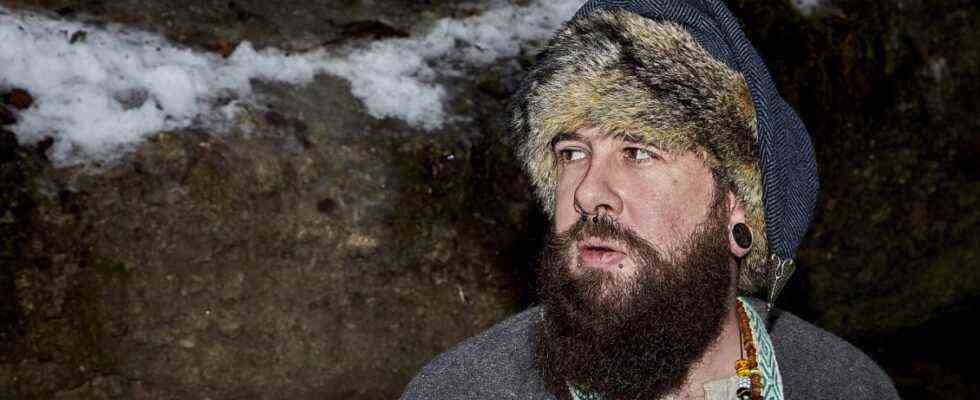The snow from the day before has turned to meltwater. With a loud roar it falls over the Tölz badger cave down into the stream bed. Despite the melting snow, an icy wind blows and creates a special atmosphere. And this is a suitable setting for the group in colorful clothing and in turn-sewn leather shoes, who have gathered here for a photo shoot: a shaman with a crooked stick is there, a warrior with beads braided into her long beard and a slave trader. Authenticity is important to the people at the badger cave, after all they do re-enactment, so they try to recreate old ways of life in appearance and costume as believably as possible.
Marinus Jennerwein, alias the slave trader, separates himself from the group: He wears a gray coat with a patterned border, a fur-trimmed cap and an amber necklace. The fingers are decorated with runes. His character has the artificial name Halfdan Gunnarson and comes from Haithabu in today’s Schleswig-Holstein. In real life, Jennerwein, 31, comes from Bad Tölz and works as a chef in Lenggries. Contrary to expectations, there is beer in his mug, because, he explains, the Vikings only drank mead on special occasions. For reasons of hygiene, diluted beer was preferred to water in everyday life – so his choice of drink is also authentic, he winks. In conversations with Marinus Jennerwein, the focus is often on the famous Kaltenberg Knights’ Tournament, a traditional medieval festival. Even as a little boy he was fascinated by it and every year in the visitor ranks, he says. “To my shame I have to say that it was the Vikings series that really inspired me.” It followed: long research work with books, documentation, internet sources. After intensive self-study, Jennerwein says: “Don’t look at Vikings, it conveys a wrong image of the Vikings,” and takes a sip from the brown mug.
For Marinus Jennerwein, this is one of the goals of re-enactment: to refute clichés about bloodthirsty warriors wrapped in skins. The Norse, he says, were primarily active in crafts and agriculture, ate mostly vegetarian food, and dressed in wool and linen. He also admires the way they treat animals and nature: “They didn’t slaughter a cow just because they were hungry for meat, they really lived together with their animals because they donated milk and warmth,” he says. A credible cuisine for Vikings is therefore not particularly meat-heavy – and by the way, not spicy either. Only herbs and salt went into the pot, says Jennerwein. As a chef, he is particularly interested in the culinary side of things, and he has tried to replicate it in a credible manner in Viking camps.
The back of Marinus Jennerwein’s hand is tattooed with a protective symbol called “Vegvísir”, meaning signpost. (Photo: Manfred Neubauer)
He’s been in the scene for four years now, has tried out various groups and brotherhoods, and visited various medieval markets and camps where performers come together to slip into their roles at festivals and parades.
Jennerwein is also active as an organizer himself: This summer he is planning to organize his Viking camp in Penzberg for the third time. He gets enthusiastic about it: the atmosphere in the camps is good, cohesion and deceleration develop when you put cell phones and the like aside. With its Viking camp, Jennerwein would like to give interested parties the opportunity to get a taste of the reenactment. He has also been a candidate in the Cullach Cuthach group from southern Germany for two years and has thus come a little closer to his dream of performing in Kaltenberg. The camp group regularly takes part in the knight games there and will appear again this year – then with Halfdan Gunnarson, whom Jennerwein wants to embody in the parade. That, too, is authentic: because slaves were the Vikings’ main commodity, he says. That’s not fun for him: he wants to use his portrayal to draw attention to global human trafficking, which is still thriving today, and is therefore in talks with human rights organizations about an awareness campaign.
It’s time for the photo shoot: Marinus Jennerwein becomes Halfdan Gunnarson. He takes his best friend in real life, Sebastian Sieber, who has now slipped into the role of Vandil Skarfason, on a leash. It’s not fun for him, says Jennerwein. Rather, he wanted to use it to draw attention to global human trafficking. (Photo: Manfred Neubauer)
Then it’s time for the photo shoot. Marinus Jennerwein becomes Halfdan Gunnarson, who takes his best friend in real life, Sebastian Sieber, who has now slipped into the role of Vandil Skarfason, as a slave: He screws a metal ring around his neck with a stick, grabs the end of the rope and yells, “Strong man for sale!” The waterfall from the snowmelt rushes into the stream bed next to it.

